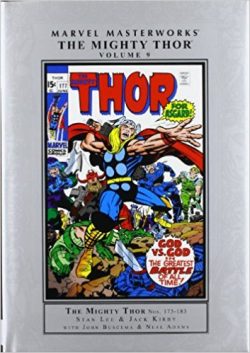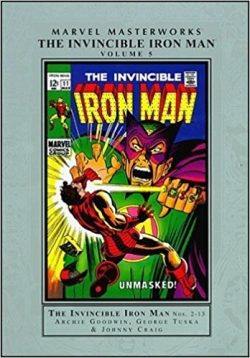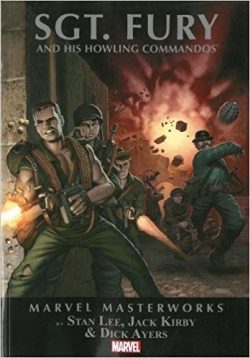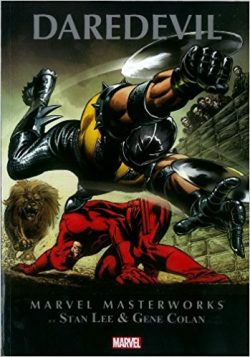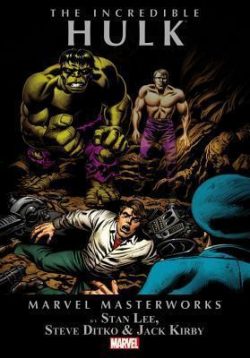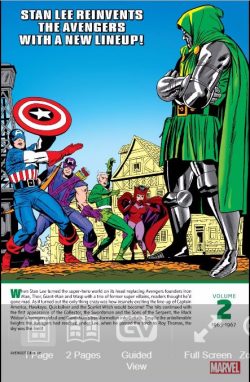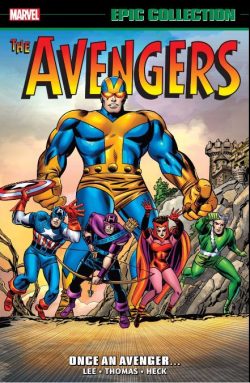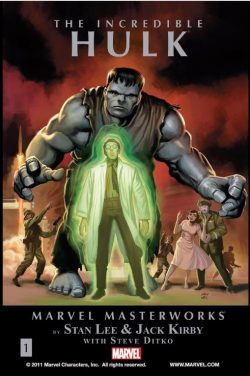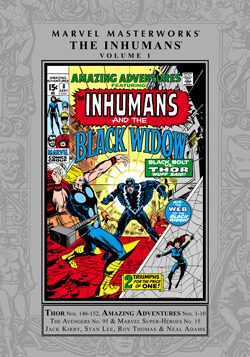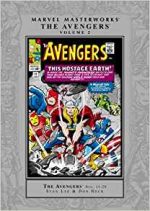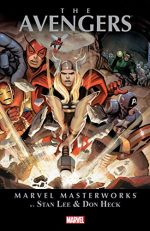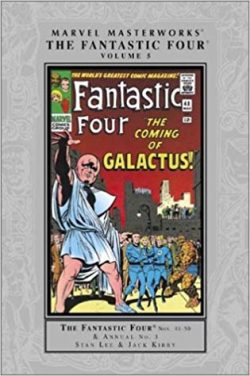
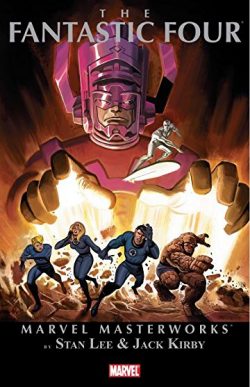
By Stan Lee & Jack Kirby with Vince Colletta, Joe Sinnott and others (Marvel)
ISBN: 978-0-7851-5058-9 (PB)Â Â Â Â Â Â Â Â Â Â Â Â Â Â Â Â Â Â Â Â :978-0-7851-1184-9 (HB)
The monolith of Marvel all started with the quirky and fractious adventures of a small super-quartet who were as much squabbling family as coolly capable costumed champions. Everything the company produces now stems from their exploits and the groundbreaking, inspired efforts of Stan Lee & Jack Kirby…
This full-colour compendium – available in hard cover, trade paperback and digital editions – collects Fantastic Four #41-50 plus the third giant-sized Annual: issues of progressive landmarks spanning August 1965 to May 1966 with Stan & Jack cannily building and consolidating an ever-expanding and cohesive shared universe with the FF as the central title and most consistently groundbreaking series of that web of cosmic creation.
As seen in the landmark premier issue, maverick scientist Reed Richards, his fiancé Sue Storm, their close friend Ben Grimm – with Sue’s tag-along teenaged brother – survived an ill-starred private space-shot after Cosmic Rays penetrated their ship’s inadequate shielding and mutated them all.
Richards’ body became elastic, Sue gained the power to turn invisible, Johnny Storm could turn into living flame and tragic Ben devolved into a shambling, rocky freak.
Eschewing preamble, the titanic tales of suspense resume here with the first chapter of a tense and traumatic trilogy (inked by Vince Colletta) in which the Frightful Four (The Wizard, Sandman, Trapster and enigmatic Madame Medusa) brainwash the despondent and increasingly isolated Thing: turning him against his former team-mates.
It starts with ‘The Brutal Betrayal of Ben Grimm!’, continues in rip-roaring fashion as ‘To Save You, Why Must I Kill You?’ pits the monster’s baffled former comrades against their friend and the world’s most insidious villains and concludes in bombastic glory with #44’s ‘Lo! There Shall be an Ending!’
After that Colletta signed off by inking one of the most crowded Marvel stories ever: Fantastic Four Annual #3. Inexplicably here it is reassigned to the back of the book however so ignore the huge chronological blip and soldier on: we’ll get there when we get there…
Cover-dated November 1965, FF #44 was a landmark in many ways. Firstly, it saw the arrival of Joe Sinnott as regular inker, a skilled brush-man with a deft line and a superb grasp of anatomy and facial expression, and an artist prepared to match Kirby’s greatest efforts with his own. Some inkers had problems with just how much detail the King would pencil in; Sinnott relished it and the effort showed. What was wonderful now became incomparable…
‘The Gentleman’s Name is Gorgon!’ introduces a mysterious powerhouse with ponderous metal hooves instead of feet, a hunter implacably stalking Medusa. She then embroils the Human Torch – and thus the whole team – in her frantic bid to escape, and that’s before the monstrous android Dragon Man shows up to complicate matters.
All this is merely prelude, however: with the next issue we are introduced to a hidden race of super-beings secretly sharing Earth with us for millennia. ‘Among us Hide… the Inhumans’ reveals Medusa to be part of the Royal Family of Attilan, a race of paranormal aristocrats on the run ever since a coup deposed the true king.
Black Bolt, Triton, Karnak and the rest would quickly become mainstays of the Marvel Universe, but their bewitching young cousin Crystal and her giant teleporting dog Lockjaw were the real stars here. For young Johnny it is love at first sight, and Crystal’s eventual fate would greatly change his character, giving him a hint of angst-ridden tragedy that resonated greatly with the generation of young readers who were growing up with the comic…
‘Those Who Would Destroy Us!’ and ‘Beware the Hidden Land!’ (FF#46 – 47) see the team join the Inhumans as Black Bolt struggles to regain the throne from his brother Maximus the Mad, only to stumble into the usurper’s plan to wipe “inferior†humanity from the Earth.
Ideas just seem to explode from Kirby at this time. Despite being halfway through one storyline, FF #48 trumpeted ‘The Coming of Galactus!’ The Inhumans saga is swiftly wrapped up by page 6, with the entire clandestine race sealed behind an impenetrable dome called the Negative Zone (later retitled the Negative Barrier to avoid confusion with the gateway to sub-space that Reed worked on for years).
Meanwhile, a cosmic entity approaches Earth, preceded by a gleaming herald on a surfboard of pure cosmic energy…
I suspect this experimental – and vaguely uncomfortable – approach to narrative mechanics was calculated and deliberate, mirroring the way TV soap operas were increasingly delivering their interwoven storylines, and used as a means to keep readers glued to the series.
They needn’t have bothered. The stories and concepts were enough…
‘If this be Doomsday!’ finds planet-eating Galactus setting up shop over the Baxter Building despite the team’s best efforts, whilst his cold and shining herald has his humanity accidentally rekindled by simply conversing with the Thing’s blind girlfriend Alicia.
Issue #50’s ‘The Startling Saga of the Silver Surfer!’ then concludes the epic in grand style as the reawakened ethical core of the Surfer and heroism of the FF buy enough time for Richards to literally save the World with a borrowed Deus ex Machina gadget…
Once again, the tale ends in the middle of the issue, and the remaining half concentrating on the team getting back to “normalâ€. To that extent, Johnny finally enrols at Metro College, desperate to forget lost love Crystal and his unnerving jaunts to the ends of the universe.
On his first day, the lad meet imposing and enigmatic Native American Wyatt Wingfoot, destined to become his greatest friend…
That would be a great place to stop but now at last you can see how Reed and Sue get hitched as Fantastic Four Annual #3 famously features every hero, most of the villains and lots of ancillary characters in the company pantheon (such as teen-romance stars Patsy Walker & Hedy Wolf and even Stan and Jack themselves).
‘Bedlam at the Baxter Building!’ spectacularly celebrates the Richards-Storm nuptials, despite a massed attack by an army of baddies mesmerised by the diabolical Doctor Doom. In its classical simplicity it signalled the end of one era and the start of another…
With these tales Lee & Kirby began a period of unmatched imagination and innovation which cemented Marvel’s dominance and confirmed that they were crafting a comics empire. The verve, conceptual scope and sheer enthusiasm shines through on every page and the wonder is there for you to share. If you’ve never thrilled to these spectacular sagas then this book of marvels is the perfect key to another – better – world and time.
© 1965, 1966, 2011, 2016 Marvel Characters, Inc. All Rights Reserved.

